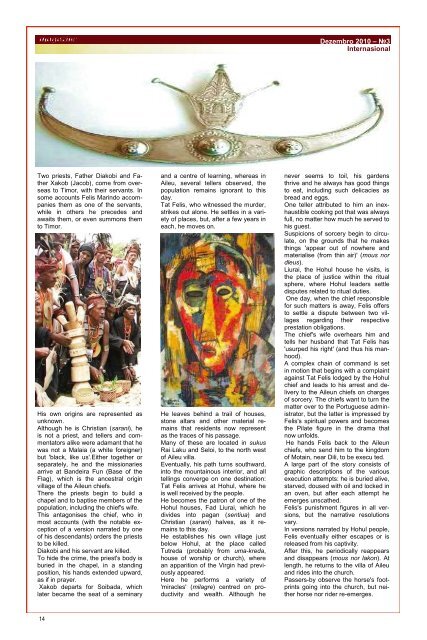IDENTIDADE TIMORENSE
IDENTIDADE TIMORENSE
IDENTIDADE TIMORENSE
Create successful ePaper yourself
Turn your PDF publications into a flip-book with our unique Google optimized e-Paper software.
Two priests, Father Diakobi and Father<br />
Xakob (Jacob), come from overseas<br />
to Timor, with their servants. In<br />
some accounts Felis Marindo accompanies<br />
them as one of the servants,<br />
while in others he precedes and<br />
awaits them, or even summons them<br />
to Timor.<br />
His own origins are represented as<br />
unknown.<br />
Although he is Christian (sarani), he<br />
is not a priest, and tellers and commentators<br />
alike were adamant that he<br />
was not a Malaia (a white foreigner)<br />
but 'black, like us'.Either together or<br />
separately, he and the missionaries<br />
arrive at Bandeira Fun (Base of the<br />
Flag), which is the ancestral origin<br />
village of the Aileun chiefs.<br />
There the priests begin to build a<br />
chapel and to baptise members of the<br />
population, including the chief's wife.<br />
This antagonises the chief, who in<br />
most accounts (with the notable exception<br />
of a version narrated by one<br />
of his descendants) orders the priests<br />
to be killed.<br />
Diakobi and his servant are killed.<br />
To hide the crime, the priest's body is<br />
buried in the chapel, in a standing<br />
position, his hands extended upward,<br />
as if in prayer.<br />
Xakob departs for Soibada, which<br />
later became the seat of a seminary<br />
14<br />
and a centre of learning, whereas in<br />
Aileu, several tellers observed, the<br />
population remains ignorant to this<br />
day.<br />
Tat Felis, who witnessed the murder,<br />
strikes out alone. He settles in a variety<br />
of places, but, after a few years in<br />
each, he moves on.<br />
He leaves behind a trail of houses,<br />
stone altars and other material remains<br />
that residents now represent<br />
as the traces of his passage.<br />
Many of these are located in sukus<br />
Rai Laku and Seloi, to the north west<br />
of Aileu villa.<br />
Eventually, his path turns southward,<br />
into the mountainous interior, and all<br />
tellings converge on one destination:<br />
Tat Felis arrives at Hohul, where he<br />
is well received by the people.<br />
He becomes the patron of one of the<br />
Hohul houses, Fad Liurai, which he<br />
divides into pagan (sentiua) and<br />
Christian (sarani) halves, as it remains<br />
to this day.<br />
He establishes his own village just<br />
below Hohul, at the place called<br />
Tutreda (probably from uma-kreda,<br />
house of worship or church), where<br />
an apparition of the Virgin had previously<br />
appeared.<br />
Here he performs a variety of<br />
'miracles' (milagre) centred on productivity<br />
and wealth. Although he<br />
Dezembro 2010 – №3<br />
Internasional<br />
never seems to toil, his gardens<br />
thrive and he always has good things<br />
to eat, including such delicacies as<br />
bread and eggs.<br />
One teller attributed to him an inexhaustible<br />
cooking pot that was always<br />
full, no matter how much he served to<br />
his guest.<br />
Suspicions of sorcery begin to circulate,<br />
on the grounds that he makes<br />
things 'appear out of nowhere and<br />
materialise (from thin air)' (mous nor<br />
dleus).<br />
Liurai, the Hohul house he visits, is<br />
the place of justice within the ritual<br />
sphere, where Hohul leaders settle<br />
disputes related to ritual duties.<br />
One day, when the chief responsible<br />
for such matters is away, Felis offers<br />
to settle a dispute between two villages<br />
regarding their respective<br />
prestation obligations.<br />
The chief's wife overhears him and<br />
tells her husband that Tat Felis has<br />
'usurped his right' (and thus his manhood).<br />
A complex chain of command is set<br />
in motion that begins with a complaint<br />
against Tat Felis lodged by the Hohul<br />
chief and leads to his arrest and delivery<br />
to the Aileun chiefs on charges<br />
of sorcery. The chiefs want to turn the<br />
matter over to the Portuguese administrator,<br />
but the latter is impressed by<br />
Felis's spiritual powers and becomes<br />
the Pilate figure in the drama that<br />
now unfolds.<br />
He hands Felis back to the Aileun<br />
chiefs, who send him to the kingdom<br />
of Motain, near Dili, to be execu ted.<br />
A large part of the story consists of<br />
graphic descriptions of the various<br />
execution attempts: he is buried alive,<br />
starved, doused with oil and locked in<br />
an oven, but after each attempt he<br />
emerges unscathed.<br />
Felis's punishment figures in all versions,<br />
but the narrative resolutions<br />
vary.<br />
In versions narrated by Hohul people,<br />
Felis eventually either escapes or is<br />
released from his captivity.<br />
After this, he periodically reappears<br />
and disappears (mous nor lakon). At<br />
length, he returns to the villa of Aileu<br />
and rides into the church.<br />
Passers-by observe the horse's footprints<br />
going into the church, but neither<br />
horse nor rider re-emerges.


